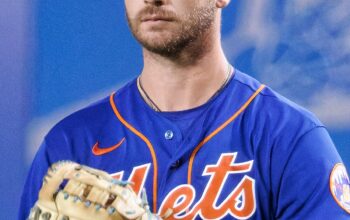NEW YORK As has become customary for them, the New York Mets lost another lead late in the game to end their homestand on Sunday. They have led through eight innings and lost six games since the beginning of May, which is four more times than any other team. Following a dismal road trip that raised concerns about the extent of their selling come trade deadline, they played ten games in a tumultuous stretch at Citi Field and finished 3–7.
As of this first week of June, the Mets (24–35) have less than a ten percent chance of qualifying for the postseason, according to websites like FanGraphs (7.6%).
Here are a few key points.
Lack of strength
There is not one specific strength for the Mets. They cannot identify a single element of the game that will enable them to continue winning. They have not won three straight games since mid-April because of this.
Scouts predicted before the season that the Mets’ lineup might be their strongest suit. That might still turn out to be the case, particularly with Francisco Alvarez back; the team has shown promise on the infrequent occasions when things have gone well. However, the offense’s performance has been mainly patchy. They generated a.697 OPS throughout the 10-game period, 13th in the major leagues, despite a few high-scoring games interspersed throughout the homestand. That is respectable, but not exactly the kind of performance that frequently offsets subpar pitching and defense.
Injuries hurt
No matter how huge the hole is created by an injury, the best teams—the New York Yankees and the Atlanta Braves immediately spring to mind—manage to overcome it. The Mets’ situation was dire due to injuries to Alvarez and Kodai Senga as well as absences from the bullpen.
The Mets went into the season depending mostly on Jose Quintana to provide consistency in Senga’s absence. Rather, the veteran’s setbacks have summed up the pitching staff’s problems throughout a disastrous season. Quintana,35, has averaged almost five innings each start and has a 5.17 ERA after allowing three runs in just four innings on Sunday. His strikeout rate of 15.7% is the lowest it has been since his debut year of 2012. The Mets’ rotation has the second-highest walk rate (9.9 percent) and the third-lowest strikeout rate (19.8 percent). The bullpen was plagued by the team’s failure to pitch past the fifth inning, particularly in the opening month of the season.
The bullpen was unable to hold leads late because Edwin Díaz was having trouble and was placed on the injured list, while Brooks Raley and Drew Smith (who was reinstated on Sunday) were not available. It did not matter if the Mets went with Adam Ottavino, Reed Garrett, or Jake Diekman—lately, things have rarely gone right in games. With a 5.01 ERA and -1.0 fWAR since May 1, the Mets’ bullpen is the second-worst in that time, trailing only the Colorado Rockies with a -0.5 fWAR. Given how frequently the group was utilized collectively in April, a regression that was likely due accounts for a portion of the problem. The requirement to cast actors in parts for which they are not appropriate accounts for another aspect of the difficulty.
Marginal moves, minimal impact
When they selected catcher Omar Narváez for assignment and acquired Luis Torrens from the Yankees as a replacement, the front management sent a positive message to the roster. They could have just let go of Narváez at that point and waited for Alvarez to arrive; he might do so this weekend or soon after. However, they didn’t. They moved, having access to Torrens. The Mets still need to choose between Torrens and Tomás Nido for the backup catcher position when Alvarez returns. In essence, the transaction showed that they want to improve the floor of their roster and things are not assured on the periphery.
Although it is the correct course of action, the remark highlights the predicament the Mets are in—there are not many more levers the front management can pull. Not yet, anyhow; last month they tried new bullpen arms, switched up the order, and gave their best pitching prospect a promotion (their best position player prospects are either injured or not yet ready for a call-up). Clubs that are.500 or below typically see a difference from calculated margin improvements. With regular duties and significant responsibilities, the Mets have required more from their best players.
Vientos deserved a chance
Giving Mark Vientos the runaround at third base last week was a wise decision by the Mets; Jose Iglesias may see some action there now and then, but Vientos gets the majority of the playing time. In light of Brett Baty’s troubles and the expectation of seeing a lot of left-handed pitching, New York thought it was time to make this move. However, Vientos also merited the opportunity. Vientos has long shown his power, but managers always assumed he would hit more than 20 home runs if given a full-time load of plate appearances. What would please the remaining numbers was always a concern. However, given the limited sample size thus far this season, club executives have stated they are heartened by a greater
Something to cling to
Despite their poor play, the Mets are still five games shy of a postseason spot in a league where six teams make it and only five have winning records. They are only prevented from beginning the apocalyptic countdown to the deadline by it. The Mets’ opponent this weekend, the Arizona Diamondbacks, proved a year ago that it is feasible to win the pennant while sneaking into the playoffs.
However, the Mets are trailing seven teams for the last wild-card position. The Miami Marlins have three less wins and four more defeats than the Mets, putting them closer to becoming the poorest team in the league than the sixth-place team. To shift the discourse regarding the trade deadline, the Mets must act swiftly and seriously. To stop at least some selling, they might need to do more than just demonstrate that they can make it to the postseason.
“The expanded playoffs certainly change what it takes to get in,” Mets president of baseball operations David Stearns said. “How it changes how you look at a specific deadline is very situation-specific in terms of team. The goal, obviously, is not just to get in. You want to get in and advance and have a run and play deep into October. So the evaluation ultimately is, do we have a team that we think is capable of doing that?”
(Top photo of Vientos: Sarah Stier / Getty Images)


